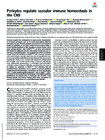Abstract
Pericytes regulate the development of organ-specific characteristics of the brain vasculature such as the blood–brain barrier (BBB) and astrocytic end-feet. Whether pericytes are involved in the control of leukocyte trafficking in the adult central nervous system (CNS), a process tightly regulated by CNS vasculature, remains elusive. Using adult pericyte-deficient mice (Pdgfbret/ret), we show that pericytes limit leukocyte infiltration into the CNS during homeostasis and autoimmune neuroinflammation. The permissiveness of the vasculature toward leukocyte trafficking in Pdgfbret/ret mice inversely correlates with vessel pericyte coverage. Upon induction of experimental autoimmune encephalomyelitis (EAE), pericyte-deficient mice die of severe atypical EAE, which can be reversed with fingolimod, indicating that the mortality is due to the massive influx of immune cells into the brain. Additionally, administration of anti-VCAM-1 and anti–ICAM-1 antibodies reduces leukocyte infiltration and diminishes the severity of atypical EAE symptoms of Pdgfbret/ret mice, indicating that the proinflammatory endothelium due to absence of pericytes facilitates exaggerated neuroinflammation. Furthermore, we show that the presence of myelin peptide-specific peripheral T cells in Pdgfbret/ret;2D2tg mice leads to the development of spontaneous neurological symptoms paralleled by the massive influx of leukocytes into the brain. These findings indicate that intrinsic changes within brain vasculature can promote the development of a neuroinflammatory disorder. Show more
Permanent link
https://doi.org/10.3929/ethz-b-000475206Publication status
publishedExternal links
Journal / series
Proceedings of the National Academy of Sciences of the United States of AmericaVolume
Pages / Article No.
Publisher
National Academy of SciencesSubject
pericyte; blood–brain barrier; leukocyte trafficking; autoimmune neuroinflammation; MOG35–55–specific T cell receptorMore
Show all metadata





